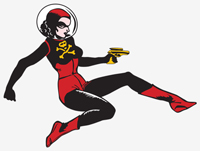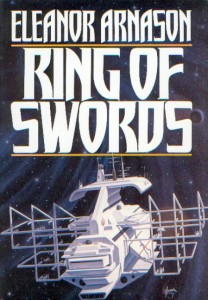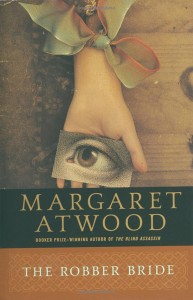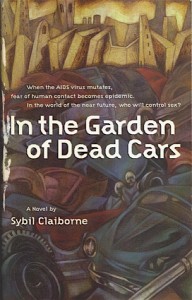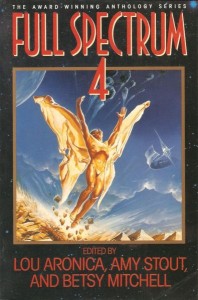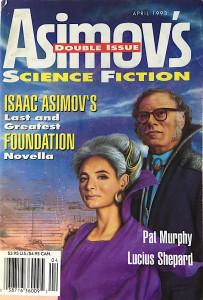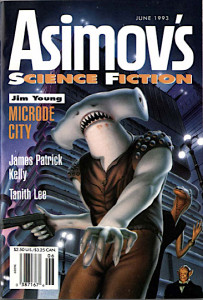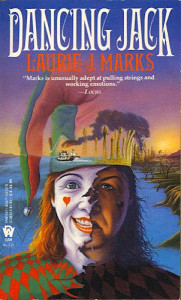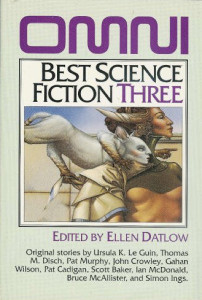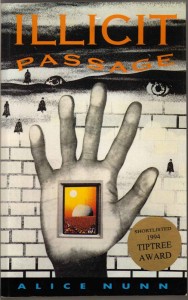The Otherwise Award is pleased to announce that the award ceremony for the 1993 Otherwise Award winner(s) has been held, and the winners have received their award and accolades.
Award Information
Conference Information
- Award Year: 1993
- Award Year Number: Year 3
- Conference: Readercon 7
- Date: 10-07-1994
- Location: Worcester, MA
Award Sections
Award Winner
The 1993 jury chose 1 work for the Otherwise Award.
Griffith details a civilization-several generations old-composed entirely of women. Her novel displays uncommon skill, a compelling narrative and a sure grasp of the complexity of civilization. While avoiding rhetoric, cant and stereotype, Griffith’s politics run subtle and deep. — Steve Brown A well-written first novel of a world on which there are no males, the men having been killed by a virus long ago. The story is told through the eyes of a woman who goes there to study the society that has evolved. This is the story of how people interact, and the evolution and adaptation of the protagonist to a world that is different from the one she’s always known. Also a novel which postulates that a society composed of only women would not be fundamentally different from one containing both genders. A real page-turner with beautifully well-drawn characters. — Susan Casper Ammonite is an interesting rite-of-passage novel in which the main character-Marghe-works out who she is and what she wants to do with her life. The culture of the planet Jeep-influenced by a virus fatal to most women and all men, that also facilitates genetic mixing and not-really-parthenogenic births-was fascinating and believable. This book is not based on “difference” gender philosophy (i.e., that women and men are basically psychologically different), and therefore, the women-only culture wasn’t portrayed as a utopia for its lack of men. Greed and mindless violence exist in this culture as in ours. Its gender-bending message was that sexuality is only a minor part of human relationships. The characters all seem to take it for granted that sexual preference is an almost irrelevant aspect of understanding one another. In fact, the lack of men in this world is important only for the fact that because of it, Jeep is quarantined from the rest of the (mainly corrupt) Federation, until and if an vaccine is discovered. The human women on Jeep are never referred to as a lesbian community. They are simply a community of people, all of whom happen to be women.— Jeanne Gomoll A self-assured, unself-conscious, convincing depiction of a world without men, this is perhaps the strongest pure science fiction on the list-doing what only SF can do, and doing it with skill and brio. Is it a gender bender? It answers the question “When you eliminate one gender, what’s left?” (a whole world, is the answer). but a lot of books like Moby Dick, eliminate one gender, and yet nobody thinks anything about it. I believe Kate Clinton has the answer: “When women go off together it’s call separatism. When men go off together it’s called Congress.” — Ursula K. Le Guin When plague wipes out all the men and many of the women of a contingent of marines, a planet is declared quarantined. Marghe is sent to study the “natives,” women left from an earlier colonization attempt which was also infected. Ammonite could have been a didactic novel or a utopian fiction, but Griffith has made her world of women complex and full of people both good and bad. — Maureen F. McHughAmmonite by Nicola Griffith (Del Ray, 1993)
Work Information
Title: AmmoniteAuthor: Nicola GriffithPublisher:
Publisher Name: Del RayCountry: USYear: 1993
Award Honor List
See full details about the 1993 Honor List
The 1993 jury chose 10 works for the Honor List A novel about human interaction with a culture where cross-gender relations are forbidden, and even contact is kept to a minimum. A lovely book, though the violent male, non-violent female aspects were a tad heavy-handed. Also suffers slightly from a read-the-next-book-in-the-series sort of ending. — Susan Casper This novel is both a rousing page-turner and idea-turner. The aliens in this book might be the technically advanced version of the aliens from Arnason’s Tiptree-winning novel, Woman of the Iron People. In both books, Arnason created an alien race whose social stability stems directly from the separation of male and female cultures. Both books are also based on the arguable premise that the male tendency toward violence differentiates gender. Given that premise, the culture and story that follows are fascinating. Both Hwarhath and Human culture must re-examine all their assumptions when the two races meet one another and begin negotiations to avoid war. — Jeanne Gomoll Both the narrators of this book use an understated, slightly self-mocking, casual tone which may lead the reader to take the story lightly. It is not a lightweight story. It is intellectually, emotionally, and ethically complex and powerful. A great deal of it is told by implication only, and so the moral solidity of the book and its symbolic and aesthetic effectiveness may pass a careless reader right by. The characters are mature, thoughtful, imperfect people, the settings are vivid, the drama is tense, and the science-fictional reinvention of gender roles is as successful as any I have ever read. The only physical gender difference between human and Hwarhath is that alien women are a little larger than the men; but the cultural gender differences are immense and their implications fascinating, both as a device for questioning human prejudice and convention, and as the basis for a very good novel. The shadowy presence of a third species runs through it both unifying its ideas and always putting all assumptions back in question-a beautiful symbolic device. A beautiful book. — Ursula K. Le Guin A story of alien contact where the male of the species is considered too volatile to have at home. Arnason examines some of our assumptions of gender by creating an alien race whose assumptions are just enough different than ours to bring ours into high relief. — Maureen F. McHugh Two young girls, minor characters in The Robber Bride, demand that all storybook characters-good and evil-be read as female. So too does Atwood portray all the main characters of The Robber Bride-good and evil-as female. This fictional warping of gender role expectations forces an understanding that is ironically more complex than the so-called real world in which behavior and archetype are frequently divided into two sets, female and male. The hint of possibly supernatural motivations, give me the excuse to include this wonderful novel on the Tiptree shortlist. — Jeanne Gomoll Though in this book Atwood does not extrapolate from gender construction as she did in Handmaid’s Tale, gender construction and the behavior and relationships forced on people by their gendered sexuality is always one of her central topics. In this case we have a major artist at the height of her powers telling a very grimm’s fairytale about what a Bad Woman does to Good Men and Good Women. It is a splendid novel, and far and away the funniest book this jury got to read. — Ursula K. Le Guin To me this is the most original book we read, and the most honest. The grim, repressive urban future seems familiar, conventional, but it grows less so as we read: its vivid, gritty reality is not borrowed, but discovered. What has happened to men, how women have adjusted to it, who the “carnals” are, all this complex matter is told with a mature and subtle simplicity, as the background to a strong love story and to the yet more powerful relationship of a daughter and a mother. — Ursula K. Le Guin Considers the very interesting premise that human sexual dimorphism (e.g., gender) is a physiological accident that might be swept away by a virus. A young girl reconsiders her body, her self and her relationship with everyone around her when she catches this virus. — Jeanne Gomoll A nineteen year old girl ! discovers that her boyfriend has given her a virus that makes her something not human, maybe not female, and the government wants to keep her quarantined. This story could have been the story of a victim but Duchamp has made Pat, her nineteen-year-old, both nineteen and anything but a victim. — Maureen F. McHugh This story is in Flying Cups and Saucers. Robertson has crafted a vivid portrait of a Native American society-the Sioux, at a time when the events of Little Big Horn are occurring just over the horizon. His main characters are two women, one enacting a warrior role and the other transvestite, that seem startlingly unlikely to our eyes. Robertson fearlessly avoids presenting his Sioux with politically correct Noble Savage stereotyping, giving us several thoughtless, cruel, even stupid examples, and ends up with a three dimensional picture of a fully human milieu. — Steve Brown A vivid story about Indian Wars of the last century that explores gender in both its look at a young woman who takes on the role of warrior to assuage her brother’s ghost, and her transvestite friend who has his eyes set on the white soldiers. — Susan Casper This story is interesting for its message that cultures based upon different understanding of humanity create dissonant communication when individuals from those cultures try to understand one another. Indians and Whites; women and men; White men and Indian women… — Jeanne Gomoll This story is in Flying Cups and Saucers. In Kelly’s vivid story, all of the interactive negotiations that transpire between lovers have been reduced to chemical transactions. One might think that this love story would end up as interesting as the purchase of a used car, but ultimately it is love story and a touching one. — Steve Brown A lovely story which makes the distinction between love and sexual attraction in a different way. A sweet love story and good science fiction. If gender-bending can be construed to mean the way men and women relate to each other sexually, as well as socially, this one nicely fills the bill. — Susan Casper a short story that starts by talking about love as if it were the interaction of chemicals and ends by making the interaction of chemicals a sweet and poignant story of love. — Maureen F. McHugh This story is in Flying Cups and Saucers. Dancing Jack is a wonderful fantasy, with a very unusual portrayal of magic and powerful portrayals of three women characters-the heroes who rescue their post-plague world. This is a wasteland story: saved not be a fisher king or a single knight, but by the combined magics of a riverboat pilot, a farmer, and a toymaker. The land is infertile, crops are not growing, animals die; people have mostly given up. The magic with which these three women reclaim life for themselves and their land is the lesson that acceptance of pain brings the possibility of joy. It turns inside out the formula of the quest and the knight-hero with gender-bending insights. — Jeanne Gomoll I thoroughly enjoyed this very realistic fantasy, but found no genderbending in it: just a fine depiction of competent, independent women working, and a very satisfying, lesbian love-story. Fantasies about grown-ups are very rare; and this is one. — Ursula K. Le Guin McDonald has taken a well-worn fictional path, that of the non-human race that has always lived in parallel with us (usually responsible for the generation of vampire mythology), and reworked it into something new. His “vampires” have a sophisticated form of pheromonal communication and an ambiguous concept of gender. Their interaction with humans is compelling, and tragic. — Steve Brown Aliens/changelings/an unrecognized third sex? McDonald doesn’t quite say where these gender-shifting people come from, but they pay a high price for a desirability far beyond that of full-time women. Touching and well-written. — Susan Casper Any story that includes in its first sentence, “Mother says he can remember Grandmother taking him…” grabs my genderbending radar. It’s a suspenseful story about aliens-among-us who change their gender at will from female to male to hermaphrodite, and who are subject to an awful AIDS-like disease. I liked it a lot. — Jeanne Gomoll This story is in Flying Cups and Saucers. One of my favorite novels of recent years, Illicit Passage concerns the actual mechanics of a feminist revolution, a revolution from within. As the individuals in the asteroid mining town in Nunn’s novel learn self-confidence, their lives change. And as the people organize, the social order changes. The establishment panics and looks for “the usual suspects”-the revolutionary agitators, the bomb-throwers, and entirely misses the secretaries, mothers, factory workers, and servants plotting radical change right under their noses. Illicit Passage is a novel of mistaken assumptions, misdirected expectations. In fact, we never actually hear the main character (Gillie) speak. We only learn about her from characters who dislike or are intensely jealous of her. That we end up liking her very much anyway, in spite of the strongly biased points of view of the other characters, only strengthens our admiration for her. — Jeanne Gomoll This novel of an alien surgically transformed into a human woman who is gradually reverting-sloughing off one human attribute after another-and the confused human man who thought he was in love with her, is a dark and wrenching experience. Park explores the shadowy alleyways of the city of gender and studies the age-old imperialist clash between rich and poor civilizations. — Steve Brown To me this ambitious and complex book is ultimately a failure both as a novel and as an exploration of gender. The self-conscious tonelessness of the narrative voice imposes a real lack of affect. As gender exploration it is seriously handicapped by the fact that there are no women in it, except a girl who is fucked on page 46 and killed on page 49. The alien called “Katherine” is supposed to have been transformed into a female or a woman, but appears, to me, merely genderless from beginning to end. The setting and mood is standard neo-Conrad-on-distant-planet. — Ursula K. Le Guin Simon, a human diplomat, falls in love with Katherine, a gifted pianist and more importantly, an alien who in ‘her’ natural state is not female. As a series of events deprive Katherine of the drugs that keep “her” human, she becomes less and less so. The book is written from multiple points of view and it becomes clear that while Simon continues to find human motivations in her actions, Katherine is more alien than he wants to know. — Maureen F. McHughRing of Swords, Hwarhath Book 1, Eleanor Arnason (Tor, US, 1993)
The Robber Bride, Margaret Atwood (Bantam Books, US, 1993)
In the Garden of Dead Cars, Sybil Claiborne (Cleis Press, US, 1993)
Motherhood, Etc., L. Timmel Duchamp (Bantam Spectra, US, 1993)
The Other Magpie, Rodrigo Garcia y Robertson (Bantam Doubleday Dell Magazines, US, 1993)
Chemistry, James Patrick Kelly (Bantam Doubleday Dell Magazines, US, 1993)
Dancing Jack, Laurie J. Marks (DAW Books, US, 1993)
Some Strange Desire, Ian McDonald (OMNI Books, US, 1993)
Illicit Passage, Alice Nunn (Woman's Redress Press, Australia, 1992)
Coelestis, Paul Park (Harper Collins, UK, 1993)
Award Long List
The 1993 jury chose 24 works for the Long List
- Crashcourse, Crashcourse Book One, Wilhelmina Baird (Ace/Berkeley, US, 1993)
I enjoyed this book for its idea about three characters trapped in a movie, not sure which events are real and which are part of the script. I especially liked the gumption of the main character, Cass, who-when it became clear that her movie was a dangerous one-didn’t just sit around waiting for the next plot development, but went out (and behind the scenes) to find out more about the genre that was trapping her, and then defended herself against the movie makers rather than the script. The relationship between Cass and her two male housemates/lovers was an interesting one. — Jeanne Gomoll
-
The cover says “A psychosexual thriller,” and though I very much wanted it to be more, that’s what this book is. Starting with a self-perceived “man in a woman’s body,” it promises a subtle exploration of an anomalous psychology, but as sadomasochism takes over the story it loses direction, becoming disappointingly predictable. — Ursula K. Le Guin
The more I think about it (and possibly rewrite it in my head so that it makes some sort of sense to me) the more I am convinced that there was no strange phenomenon in this story at all, simply an abused woman who wanted to fight back. But since she is convinced that society defines women as being incapable of the kind of worldview and behavior she aspires to, her subconscious provides her with an release for her “inappropriate” feelings: she’s not a woman after all…. I was disappointed however, that male behavior, for the purpose of this story, was almost totally defined as sadomasochism. — Jeanne Gomoll
-
I was first impressed by how eager Brin seems to be to enter into the discussion of feminist issues in SF, enough so that he signaled his intentions by labeling various towns and groups “Ursulaburg,” “Vondaites,” “Tiamatians,” “Perkites,” and “Herlandia.” Brin’s main thesis seems to be that feminist utopian writing endorses the idea that technology is evil and the pastoral culture is the only good culture. At one point in Glory Season, the male hero says that the galactic federation will not allow the pastoral, anti-technological culture to continue once it regains control of its lost matriarchal colony. Brin says throughout the novel that pastoral culture can only be maintained at the expense of humanity, history and finally, of survival. He says, by implication, (with all those towns and groups of women named after well known feminist SF writers) that feminist SF fiction endorses an anti-human, anti-historical, anti-survival ethic.
If anything, Brin attempts to strengthen the familiar gender assumptions. There is little gender-bending in this novel. — Jeanne Gomoll
A very ambitious book with a courageous program of gender-exploration, seriously weakened by the author’s dislike or distrust of his own invention. It is worth asking why male authors inventing a society of women tend to make the women all alike: the old “hive worlds” of the pulp days, or, in this case, clones. It is worth asking why the male assumption so often is that a society genuinely run by women (as opposed to one run by women under the control of men) would be static, rigid, closed to change, closed to thought, needing to be saved from itself by a man. And it is worth asking why male authors so often show women as inherently anti-technological. Brin begs this last question in his afterward, saying that “This novel depicts a society that is conservative by design, not because of something intrinsic to a world led by women.” All the same, he chose to depict that society.
Though the book is unnecessarily long, the storyline is plausible and fast-moving, with well-imagined details; the social institutions of Stratos are carefully worked out; it is in the characters and the language that the book fails. p. 44: “Among the ambitions she shared with Leie was to build a hall of their own, where she might yet learn what delights were possible-unlikely as it seemed-in mingling her body with one such as those, so hirsute and huge. Just trying to imagine made her head hurt in strange ways.” p. 55: “‘I knew him,’ Odo went on. ‘Virile, summer-rampant in frost season, a sick envy of my own sisters!’ Odo leaned forward her eyes loathing, ‘He never touched you, yet he was and remains yours. That, my rutty little virgin, is why I’ll have a price from my Lysos-cursed clan, which I served all my wasted life. Your company in hell.'” The silliness of the language faithfully renders gender-stereotyped emotions (a woman irresistibly drawn to men; a woman hating another woman because of a man). This world of women is totally male-centered. Despite his excellent apparatus of clones and clans and sexual seasons, Brin hasn’t really got us any farther than about 1955. It is too bad, because the book has a likable freshness and optimism. — Ursula K. Le Guin
-
Brite mixes artists and rock and roll, New Orleans, comic books, computer hackers and a slow and sleepy southern town. The main characters are gay or bisexual, but not particularly gender bending. Horror isn’t my balliwick, but if you like your books full of atmosphere and your heros decadent in the long tradition that began with Lord Byron, you’ll eat this one up. — Maureen F. McHugh
- Lost Girls, Pat Cadigan (Mark V. Zeiseing Books, US, 1993)
A cute story in which Pan returns for generation after generation of Wendys, finding each less and less willing to take the convenient role of cook and housekeeper until finally one sets herself up in competition. A nice updated look at the Barrie legend. — Susan Casper
This is a fun story. I’ve always been fascinated by Peter Pan: a play in which the main character is nearly always played by a female actress. I think of Peter as a splintered character. Peter and Wendy are two parts of the same whole, splintered by the society which carefully segregates boys’ behavior from girls’ behavior. I liked Cadigan’s take on this strange story in which it is suggested that eventually Wendy’s descendant won’t be content with her limited role. — Jeanne Gomoll
-
Women lead this Irish revolution, but I found them unconvincing both as women and as revolutionaries. Merely changing the hero’s gender does not undo the heroic fallacy; and a long history of women’s collision with their oppressors can’t be credibly reversed by a few fits of righteous indignation. — Ursula K. Le Guin
-
A culture in which an infertile woman is called, and treated as a man: this is a promising place to explore gender in. Somehow the exploration never seems to happen, perhaps because it is derailed by religious issues. I wanted this book to have the kind of power Handmaid’s Tale has; but it doesn’t-it somehow slides away from its own central issues. — Ursula K. Le Guin
- Harm's Way, Colin Greenland (Avon, US, 1993)
Harm’s Way is farcical Dickensian fantasy set in a universe that might have been constructed by Kepler or Jules Verne, A young girl plays the part normally played by the male adolescent-the outrageously, naive youth who has picaresque adventures, learns the Shocking Truth about her ancestry and Grows Up. — Jeanne Gomoll
-
This is a great SF love story. The SF element-the light-activated orchestral machines, and a person who can “play” it with her body-is a fascinating one. But does the fact that the lovers are lesbians make this gender-bending? — Jeanne Gomoll
- The Assimilation of Leah Wennover, Stephanie T. Hoppe (Evoe Press, US, 1993)
This is the story of Holdfast and her two fellow time-travelers, Tai and Heart’s-ease who attempt to rescue the spirits of women killed as witches in the Burning Years. The trio also play the roles of the three female archetypes: spinner, weaver, and cutter; symbols of birth, life and death. Invisibly they bear witness to the crushing of a woman’s spirit (Leah Wennover) and assimilate her spirit, rescuing it from a time she was not allowed to live. The idea of this story bears a resemblance to the idea behind the Tiptree Award: to look again and rescue. — Jeanne Gomoll
-
A cute little story about a metaphysical cat house where the prostitutes may or may not be female or male; one never knows until they come. The image of these androgynous creatures is nicely done. — Jeanne Gomoll
-
A funny little tale about the uses we’ll put our past and present lovers to, once we have the ability to make a virtual, keepsake copy of them. — Susan Casper
- Songs of Chaos, Shariann Lewitt (Ace Books, US, 1993)
The story impressed me less than the setting-this fantastic, organic cyberpunked Brazilian rainforest transplanted onto a space station in which parrots act as living monitors, sort of. The outsider, Dante, discovers that the very thing that makes him an outcast in one world makes him a powerful genius in Mangueira. Skinny Fatima thinks she’s an outsider and different from everyone else in Mangueira, and she too discovers that the thing that makes her different turns out to be her most valuable contribution to the community. Bisexual relationships on board the Mangueira are accepted as the norm. — Jeanne Gomoll
Highly competent and enjoyable, with a nice, original take on virtuality, great parrots, good men characters, good women characters; but no bending of gender that I could see. — Ursula K. Le Guin
- Evolution Annie and Other Stories, Rosaleen Love (ed.) (The Women's Press, UK, 1993)
Imaginative, funny, spirited, subversive, many of these stories explore and play with gender and gender-roles in one way or another. The title story sets the stuff about Man the Hunter and the Ascent of Man and all that on its ear: “The Daughters of Darius” is a haunting tale/meditation; and “Strange Things Grow at Chernobyl” packs immense power into six understated pages. — Ursula K. Le Guin
-
The story of The Year the Horses Came-a matriarchy demo posing as an adventure travelogue-is set at the crux of change, just before the patriarchal, misogynist, horse-riding hordes sweep across the continent from the east. The main character travels from the far western edge of the matriarchy, east into the territory of the marauders. I was sympathetic with Mackey’s conviction that culture is molded by the way its members raise their children and by its cosmological assumptions, but less impressed by the ponderous storyline. — Jeanne Gomoll
Woman-centered, goddess-worshipping, free people of prehistoric Western Europe meet up with the male-dominant, aggressive horse-riders of the Steppes. The rather naive “agenda” overwhelms the novel, but there are some vivid scenes and good moments of culture-shock. — Ursula K. Le Guin
- An Eye for Dark Places, Norma Marden (Little, Brown, US, 1993)
Norma Marden’s An Eye for Dark Places is an extraordinary book. Its portrayal of a woman stifled in an unrewarding marriage reminded me strongly of Perkins’s The Yellow Wallpaper. Through a possibly imagined journey into a fantastic, utopian world beneath London, she comes to understand the kind of relationship and life she wants, and when she returns, she leaves her family and starts a new life. — Jeanne Gomoll
I did a cover quote for this book, saying “This spare, radiant book emotionally exact and profoundly imagined, is an extraordinary first novel.” As a genderbender I think it breaks no new ground; but as an exploration of human/sexual/familial relationships up to and perhaps over the edge of madness, it is very fine. — Ursula K. Le Guin
-
Deerskin reexamines fairy tale archetypes (the perfectly beautiful princess who falls in love with the perfectly handsome prince and the happily-ever-after period that is presumed to naturally follow such a perfect match). It’s a great story, and its genderbending aspect has to do with the way fairy tale archetypes get under our skin and get confused with morality and gender definitions. Its plot follows the child of the perfect royal couple after her father rapes her, and her recovery from that experience. — Jeanne Gomoll
A strong-indeed a superhumanly endowed and unerring-female protagonist does not in herself constitute a genderbending novel, even when she is an abuse survivor. This fantasy might be a good “role-model” book for girls, but I found the heroine way too tall, beautiful, gifted, etc. to identify with. — Ursula K. Le Guin
- The Best Lives of Our Years, A. R. Morlan (Bantam Spectra, US, 1993)
Set in the next century after one of those pesky, gender-specific diseases has struck down most of the men in the world. At first, everyone expects that the world will become a more sane-or at least a less violent-place. Instead, war becomes more terrible than it ever was, because women feel they must prove themselves in the absence of men. The story is told by way of letter excerpts written by successive generations of women soldiers. Pretty depressing script, but jolting reminder that when the powerless gain power, they frequently adapt their behavior to their new role. — Jeanne Gomoll
-
The foreground of Nagata’s story is a Moslem society in which the women characters struggle against powerful religious constraints. With the placement of a memory chip containing a mother’s personality into the brain of a daughter, Nagata also is able to speculate on some unusual potentials in the mother/daughter relationship. — Steve Brown
-
An entertaining novel about a spacer and famous gamer/author, Quinn Lioe, who takes leave on the planet Burning Bright during its annual storm festival, in order to play “the game.” The game is played across several empires in the galaxy and involves one fictional world and several plot lines (empire, revolution, court intrigue, psi wars, etc.) which are mirrored in the situation Lioe finds herself enmeshed in real life on Burning Bright. In fact, by the end of the novel, it is clear that she has brought the game’s plot to a conclusion and will begin a new game that involve players in active commentary and involvement in the real world. The genderbending element of this novel has to do with the society’s tolerance of all sexual preferences. There are lots of ways to bet into trouble in this world, but none of them involve personal sexual behavior. Most of the characters appear to be bisexual. — Jeanne Gomoll
- A Defense of the Social Contracts, Martha Soukup (Sovereign Media Co., US, 1993)
Maybe the world would be a better place if everyone was required to wear nametags identifying their sexual preferences. Soukup extrapolates upon this idea and imagines a world in which everyone must declare themselves monogamous, non-monogamous, celibate, or group family types. Fascinating. I couldn’t figure out whether she believed that such categorization was doomed from the start-because we can’t enforce who falls in love with whom; or whether she thinks that such a system would at least start to sort out the confusion. I liked this story a lot. — Jeanne Gomoll
- The Story So Far, Martha Soukup (Bantam Spectra, US, 1993)
This story is a sort of Rosencrantz and Guildenstern based upon 1950s romances rather than Hamlet. The main character of this story is a mere spear-carrier in another story which centers around her husband, Dennis. Throughout “The Story So Far,” Emily tries to figure out the plot of the short story in which she is enmeshed, and is dismayed to learn that the main plot line proceeds entirely while she is offstage. She learns that both she and another woman character are entirely superficial to Dennis and the plot, but despite this revelation the two fictional woman characters strive for actual existence. This genderbending story concerns itself with gender as defined by (B-rated) literature rather than by life. — Jeanne Gomoll
-
Like many of Tepper’s novels, it contains a chunk of gender commentary. In nearly all of her books, and she deals with gender in a very interesting ways. A Plague of Angels further develops Tepper’s favorite idea of gods created by people and the worlds they inhabit-sort of a self-conscious Gaean system, applied to all worlds with intelligent life. In Plague, the self-conscious earth deity intervenes in human history to repair the human/nature balance-so badly skewed that people are on the brink of extinction. Along the way, Tepper delves into the idea that men and women cannot live together without damaging one another-given the way women and men are currently socialized. One of the few hopeful communities in this world is one in which men and women live mostly separately, getting together now and then, and learning-within their subgroups-to change their ideas about gender. — Jeanne Gomoll
I wish Tepper would spend more time rewriting. There’s great stuff in this, but it’s shapeless and repetitive. As in so many of her books, a great beginning goes dry in pointlessly complex plotting about the villainous fools who run things. The paranoid element that was part of the strength of her real gender-exploring novel, The Gate to Women’s Country, here is a weakness; and the gender roles are conventional. — Ursula K. Le Guin
- Virtual Girl, Amy Thomson (Ace/Berkeley, US, 1993)
Virtual Girl is a re-working of the Pygmalion myth, of a man creating his idea of a perfect woman, who then turns into a real person and leaves him. In this case, the male creator is a nerdish hacker who creates a cyborg woman. In a moment of crisis, the cyborg hears only a portion of a command/programming input, “You are the most important thing to me.” All she hears is “You are the most important thing,” and from that, she entirely re-programs herself. Self-actualization saves her life, but dooms the odd couple’s relationship. — Jeanne Gomoll
Jurors
Commentary was harvested from correspondence among the judges and attributed by the judges’ names.
- Jeanne Gomoll (chair)
- Steve Brown
- Susan Casper
- Ursula K. Le Guin
- Maureen F. McHugh
Award Ceremony
See full details about the 1993 Ceremony
The 1993 Otherwise Award was given to Nicola Griffith at ReaderCon 7, July 10, 1994, in Worcester, Massachusetts.
